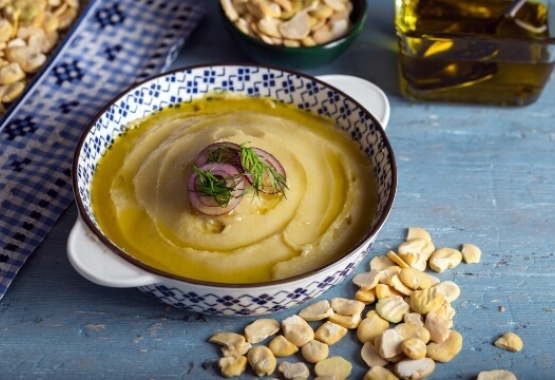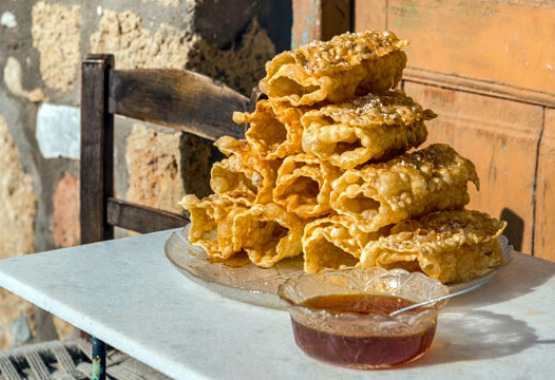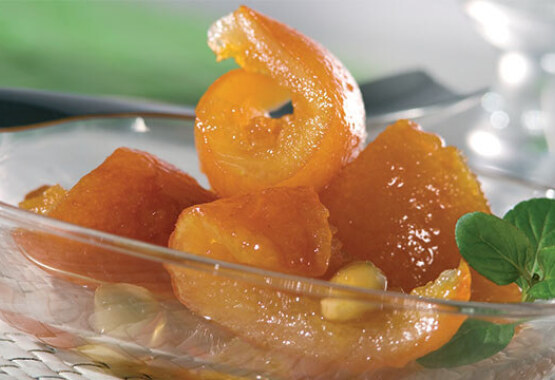
AROUND GREECE
Here’s a hint about the variety of vasilopita ingredients used across the country: On Zante Island, bread is kneaded with sourdough, almonds and spices; on Crete it is kneaded with tsikoudia (or raki – a local strong spirit) and powdered mastic drops; in the north of Greece, locals prepare a pie made with sesame or a sweet pumpkin pie; on Lesvos Island it is made with myzithra cheese; in Epirus Region pies are filled with meat (lamb or pork), feta cheese and plenty of spearmint.
There are also differences in the way they are decorated or sized, although some decorations are used on most Vasilopitas: the number of the New Year is written with blanched almonds or with sugar (on a sweet cake); a round shape; and flouri, a coin which may sometimes be a gold or a silver one, placed in the dough before or after it is baked.
Try: Vasilopita with citrus fruit
The cake (or pie) is a symbol of good luck for the new year and everyone gathers around the table in happy anticipation of the cutting process, as, according to popular belief, the person who finds the lucky coin (flouri) will have good fortune all year long!! It is customary for the householder to make the sign of the cross on the cake with a knife and then start cutting the pieces and naming the owner of each piece: the first piece is for Christ, the second is for Virgin Mary, the third is for St. Basil, the fourth is for the house, (some people also cut a piece for the poor), and the following pieces are given to family members by order of age. In villages, the livestock, the family field, the fishing boat or the mill all get their own piece of the cake.
Happy New Year!
St. Basil's Cake
Vasilopita
On New Year’s Day, a happy custom observed in almost every household in the country is about a sweet-tasting lucky treat: Vasilopita (meaning St. Basil’s Cake). Across Greece, recipes are quite a few; they all have one basic ingredient though: the much sought-after flouri [lucky coin]! Here’s the story behind this centuries-old tradition!Variations & recipes
Looking for the origin of the Vasilopita custom, we’ll take you on a trip back to the Greek antiquity period. Ancient Greeks would offer bread and honey-kneaded sweets to honour the gods during the major harvest festivals. Today the New Year’s Day Cake/Pie custom is kept everywhere in Greece, and the variety of recipes used is connected to the culinary tradition of each area: sweet bread, cake or tsoureki; phyllo dough sheet sweet or savoury pies made in Macedonia and Epirus, as these two areas are well-known for their traditional pie-making. In Athens, the most popular recipe for the New Year’s Day Cake is the one called Politiki Vasilopita and the main ingredients are flour, eggs, sugar and milk: it comes in all shapes and types but usually it is a sweet puffy cake.Here’s a hint about the variety of vasilopita ingredients used across the country: On Zante Island, bread is kneaded with sourdough, almonds and spices; on Crete it is kneaded with tsikoudia (or raki – a local strong spirit) and powdered mastic drops; in the north of Greece, locals prepare a pie made with sesame or a sweet pumpkin pie; on Lesvos Island it is made with myzithra cheese; in Epirus Region pies are filled with meat (lamb or pork), feta cheese and plenty of spearmint.
There are also differences in the way they are decorated or sized, although some decorations are used on most Vasilopitas: the number of the New Year is written with blanched almonds or with sugar (on a sweet cake); a round shape; and flouri, a coin which may sometimes be a gold or a silver one, placed in the dough before or after it is baked.
Try: Vasilopita with citrus fruit
The gold coin custom
According to tradition, when St. Basil was bishop of Caesarea, in Cappadocia (modern day Central Anatolia), the then Prefect of Cappadocia visited the town to collect taxes. The scared Caesareans, following the advice of their prelate, gathered whatever precious items they possessed and went out to greet the prefect. Saint Basil managed to persuade him not to deprive the locals of their valuables. Then, a new problem arose: how to return the precious items to their rightful owners! St. Basil asked the locals to prepare small pies and then he placed one piece inside each pie. By miracle, each one got back the item they owned!The star of the day
The table on New Year’s Day is laid with an assortment of delicious-looking dishes and traditional sweets with honey such as mouthwatering melomakarona, fried pancakes, loukoumades and diples, yet the star of the day is none other than vasilopita!The cake (or pie) is a symbol of good luck for the new year and everyone gathers around the table in happy anticipation of the cutting process, as, according to popular belief, the person who finds the lucky coin (flouri) will have good fortune all year long!! It is customary for the householder to make the sign of the cross on the cake with a knife and then start cutting the pieces and naming the owner of each piece: the first piece is for Christ, the second is for Virgin Mary, the third is for St. Basil, the fourth is for the house, (some people also cut a piece for the poor), and the following pieces are given to family members by order of age. In villages, the livestock, the family field, the fishing boat or the mill all get their own piece of the cake.
Happy New Year!




